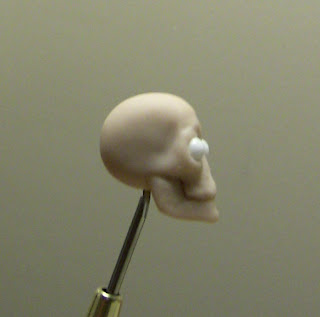
This is a scaled model of a Caucasoid male skull which I made for my make-up crew at the theatre. Please notice the many planes and ridges which make up the human skull topography. A few of the items we want to concern ourselves with are as follows: The eye socket is placed just above the halfway point of the face. The upper 1/3 to 1/2 of the nose is supported by bone while the lower section is cartilage and skin. The upper and lower jaws protrude forward from the plane of the face.( This feature is more pronounced in Negroid skulls.)
Frontal view of the skull. Note the size and number of the teeth in the jaw. The upper teeth tend to be larger than the lower teeth and have a slight over-hang all the way around the mouth.
Top



This is the skull I use for sculpting. Note the lack of prominent contrasts in the ridges and planes. The yeas are set about a bead width apart and protrude from the socket slightly.
Here you can see that I have removed the nose structure completely so I can attach a larger or smaller nose without the underlying armature getting in the way.
For the steps of the head lay up, please see the TRISTAN blog.
The finished head has been sculpted following the steps we did in the Tristan sculpt. The character is now added to the face by giving him a slight smirk and a raised eyebrow on one side.
Once again it is important to be observant when dealing with the underlying muscle as you complete the details. As the eyebrow is pulled away from the eye the opening of the eye increases and the shin above and to the side of the brow will need to crease.
When the mouth starts a smile the nasal-labial fold will deepen as the muscle around the mouth is pulled under the cheek. The tissue above this fold will become rounder from the fold to the eye socket.
The lips start to thin as the smile widens because the tissue is pulled across the underlying bone and teeth. The outside edge of the nostril will rise in relation to the amount of smile.
As the skin is pulled and bunches, you will see more creases both large and small in the skin beyond the effected areas.
Onto hands tomorrow. Have a great day!






Amazing!!! You're really talented! I Love your style and work too!! ^___-
ReplyDeleteThank you Mark for teaching this I understand where I went wrong with mine now . your first skull is amazing looks real ..My son told me that I was the only person he knew that could make a skull look like it was smiling .You know I have to show him I can do a regular looking skull now .lol Thank you .I truly love your teaching :)
ReplyDeleteThank you Mark...sometimes we can't see what we are looking at..lol! Your explainations are like having a new pair of glasses.
ReplyDeleteLooking forward to tomorrow..
xxx
Morena
YOU ROCK dear Mark!!!!! Can't wait for my materials to get here so I can play with clay along with you.....
ReplyDeletewow, that is amazing! you're such an inspiration! I want to go home and finish my sculpt.
ReplyDeleteMarisa
Mark You are an amazing artist!! I wish I had half of this kind of talent ! I am no where near sculpting along like this .. Am I allowed to print these scult alongs for future references?
ReplyDeleteThank you for doing this and i hope to see alot more of these scuplt alongs!
Shannon
Shannon, you have raised an issue here over which which my wife and I debated for a long time now. Am I giving away my livelihood? I am primarily an artist who wants to help other artists with whatever information I have. I am also an author and teacher. Many of these tips and observations are part of my existing book, DVD, and classes or will be included in future books or other media. As soon as I write something here, it becomes general knowledge. I am fine with that. I hope that those following will not attempt to profit from my work by printing this as his or her own but rather use the knowledge as a starting point for your own techniques.
ReplyDeleteI will be leaving these blogs up for the foreseeable future so the information in them will still be available. I will only delete them when artists decide they have no more use and stop viewing them. I suppose what I am saying is that I have no problem with you printing this for your own use. If you want to share them, just direct people here.
Mark, this is sensational information. I thank you so much for allowing others to watch you and advise us as you create. It's so generous to share your experience and talent with the rest of. And I'm sure creating this blog, with all the pictures, is time-consuming, and that makes me even more appreciative. I am truly inspired!!
ReplyDelete